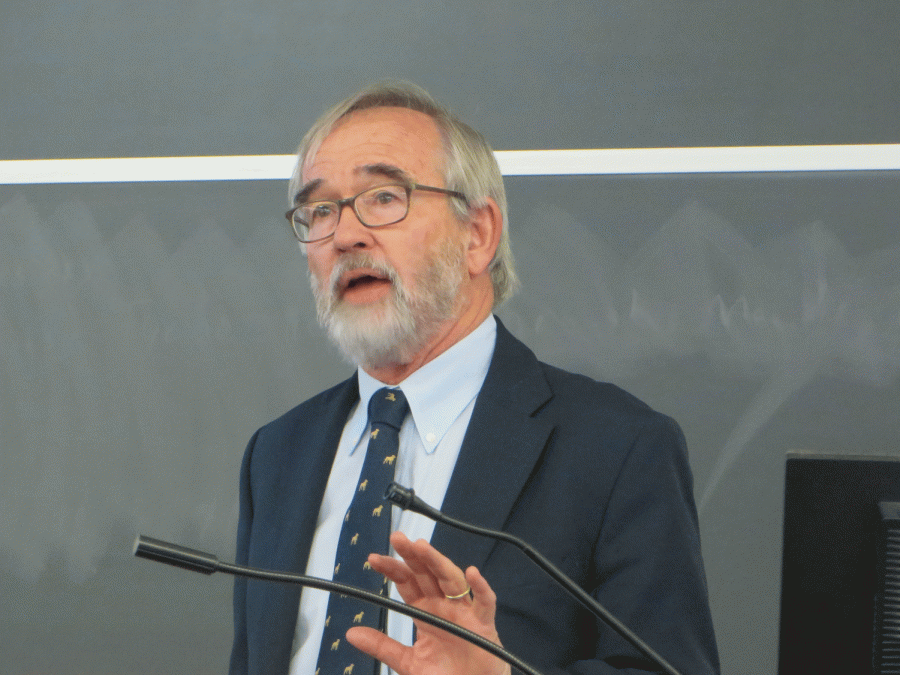Dr. Reilly Lectures on the Past, Present and Future of Genetic Privacy
On Friday, October 13, Dr. Philip Reilly gave a lecture entitled “Genetic Privacy: 50 Years of Erosion?” in the Robert H.N. Ho Science Center. Here, Reilly discussed the past, present and future of genetic privacy. Dr. Reilly stated during the beginning of his talk that the question mark was a later addition to the lecture’s title. He asked the question of whether there truly has been a deterioration of genetic privacy and emphasized how this generation will be able to decide and shape the future of genetic privacy.
This concept of “privacy” is somewhat a product of the culture’s notion of private property and the notion that individuals should have reasonable control over how others acquire and use information about them. However, legal privacy is almost entirely based on the landmark Roe v. Wade decision granting women privacy and bodily autonomy. “Privacy” in its modern form has relatively little legal grounding.
Over the past fifty years genetic information has become increasingly accessible and inexpensive. From 1907 to 1945, the concept of “eugenics” was commonly discussed in magazines and textbooks and there existed a cultural urge to adopt genetic information for social purposes. It was not until 1956 that the correct number of chromosomes in humans – 46 – had even been found. In 2001, at a cost of three billion dollars, a human genome draft sequence was produced. However, in 2017 the average person is now able to purchase their full genome for one thousand dollars. This relatively extreme change in the accessibility of genetic information is a fairly recent innovation and will only become increasingly inexpensive.
Through numerous public health efforts to screen for various conditions, most people born after 1962 have undergone some sort of genetic testing for disease by some compulsory state law. Through mechanisms of the state such as the public school system and the distribution of marriage licenses, the state is able to regulate and control public health matters and control mass genetic testing.
First-year Jessica Thienel was worried about risking her own genetic privacy.
“I personally feel uncomfortable with the idea of potential employers or even the government having unregulated access to my genetic information,” Thienel said.
One condition that has been commonly tested for in embryos is the neural tube defect. After the testing for this defect became accessible, there was a 95% decrease in the number of live births with the neural tube defect. However, Dr. Reilly argues that there exists an illusion of certainty of information when it comes to in-utero predictions. While testing like this is arguably beneficial, it does not account for the many children that can be born with these types of defects and are able to have a relatively “normal” quality of life.
First-year Christina Weiler offered her own views on the morality of genetic testing.
“Genetic testing used to prevent children from being born with severe health conditions would be beneficial in improving the quality of life of future generations – for instance, a child born without a paralyzing disorder has greater access to educational, and ultimately professional opportunities. However, manipulating genomes of an unborn fetus to achieve a certain physical look would be unethical,” Weiler said.
The immediate potential risks of increased genetic testing are access to life insurance and long-term care. Insurance companies would find clear value in possessing the genetic information of a customer and could potentially find and charge for pre-existing conditions using this information. However, the future holds the potential for an entirely new era of fetal genomic screening and an increase in the termination of “wanted pregnancies” due to test results. In the near future, testing could be as simple as a blood draw from which the fetus’s DNA could be extracted, amplified and sequenced.
Though a lack of genetic privacy and the potential for intense social selection characterize innovation in the field of genetics, in actuality genetic innovation has been beneficial to society in many ways. DNA forensics has been extremely useful in terms of rape cases, and other matters of criminal justice. While a future where fetuses are frequently tested and children are selected for characteristics may seem imminent and dangerous, the benefits of genetic testing have been integral to modern criminal investigations and an overall decrease in the number of live births of infants with certain common birth defects. Overall, there have been beneficial effects of genetic innovation. The topic of genetic privacy provides an opportunity for this generation to ask important social, moral, and scientific questions about the world we are creating.
Contact Shelby Stevens







